Significance of Health Informatics in Healthcare System
VerifiedAdded on 2023/06/10
|10
|2519
|407
AI Summary
The article discusses the significance of health informatics in controlling healthcare costs and improving the quality of treatment approaches. It also highlights the benefits and cost of four health informatics applications along with literature review of ten articles related to health informatics.
Contribute Materials
Your contribution can guide someone’s learning journey. Share your
documents today.
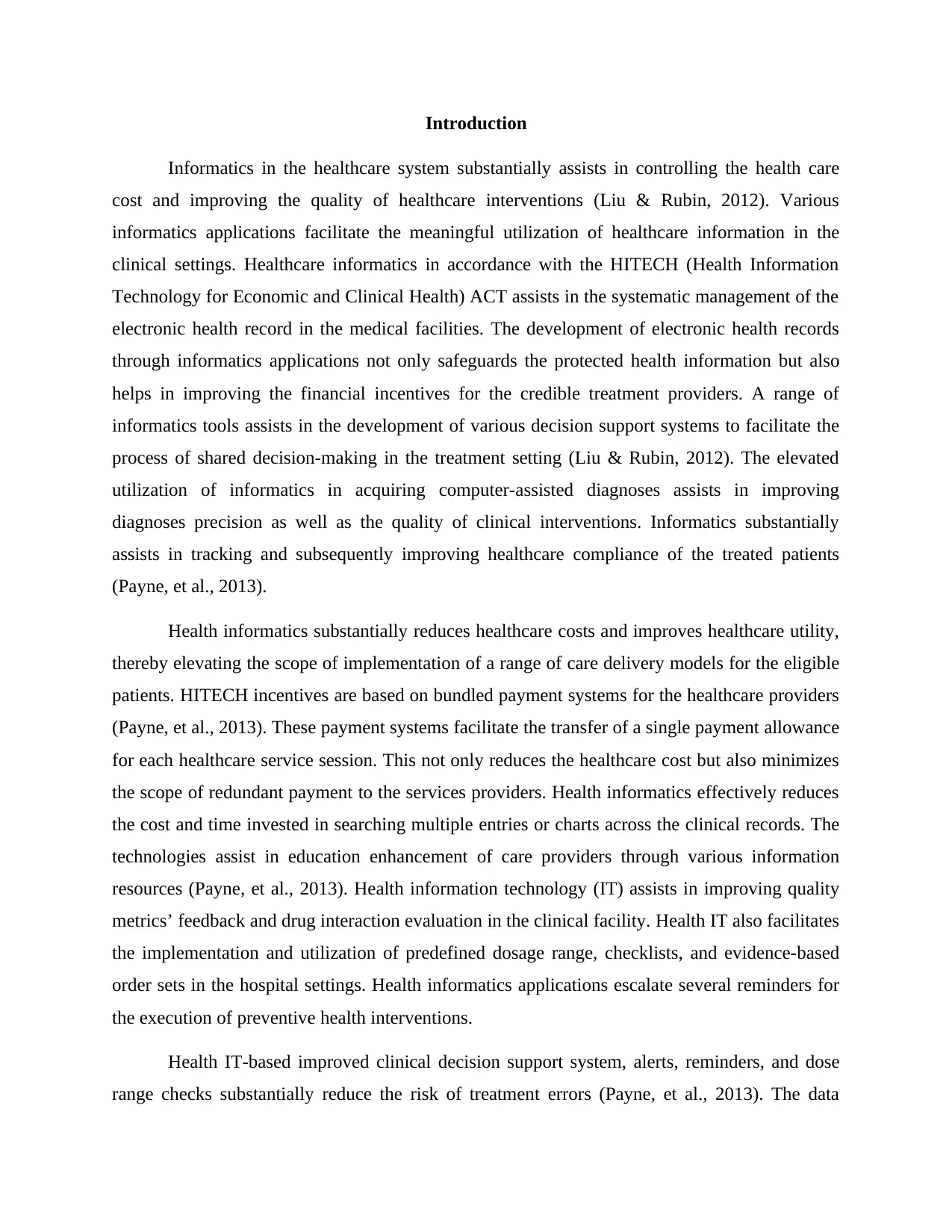
Introduction
Informatics in the healthcare system substantially assists in controlling the health care
cost and improving the quality of healthcare interventions (Liu & Rubin, 2012). Various
informatics applications facilitate the meaningful utilization of healthcare information in the
clinical settings. Healthcare informatics in accordance with the HITECH (Health Information
Technology for Economic and Clinical Health) ACT assists in the systematic management of the
electronic health record in the medical facilities. The development of electronic health records
through informatics applications not only safeguards the protected health information but also
helps in improving the financial incentives for the credible treatment providers. A range of
informatics tools assists in the development of various decision support systems to facilitate the
process of shared decision-making in the treatment setting (Liu & Rubin, 2012). The elevated
utilization of informatics in acquiring computer-assisted diagnoses assists in improving
diagnoses precision as well as the quality of clinical interventions. Informatics substantially
assists in tracking and subsequently improving healthcare compliance of the treated patients
(Payne, et al., 2013).
Health informatics substantially reduces healthcare costs and improves healthcare utility,
thereby elevating the scope of implementation of a range of care delivery models for the eligible
patients. HITECH incentives are based on bundled payment systems for the healthcare providers
(Payne, et al., 2013). These payment systems facilitate the transfer of a single payment allowance
for each healthcare service session. This not only reduces the healthcare cost but also minimizes
the scope of redundant payment to the services providers. Health informatics effectively reduces
the cost and time invested in searching multiple entries or charts across the clinical records. The
technologies assist in education enhancement of care providers through various information
resources (Payne, et al., 2013). Health information technology (IT) assists in improving quality
metrics’ feedback and drug interaction evaluation in the clinical facility. Health IT also facilitates
the implementation and utilization of predefined dosage range, checklists, and evidence-based
order sets in the hospital settings. Health informatics applications escalate several reminders for
the execution of preventive health interventions.
Health IT-based improved clinical decision support system, alerts, reminders, and dose
range checks substantially reduce the risk of treatment errors (Payne, et al., 2013). The data
Informatics in the healthcare system substantially assists in controlling the health care
cost and improving the quality of healthcare interventions (Liu & Rubin, 2012). Various
informatics applications facilitate the meaningful utilization of healthcare information in the
clinical settings. Healthcare informatics in accordance with the HITECH (Health Information
Technology for Economic and Clinical Health) ACT assists in the systematic management of the
electronic health record in the medical facilities. The development of electronic health records
through informatics applications not only safeguards the protected health information but also
helps in improving the financial incentives for the credible treatment providers. A range of
informatics tools assists in the development of various decision support systems to facilitate the
process of shared decision-making in the treatment setting (Liu & Rubin, 2012). The elevated
utilization of informatics in acquiring computer-assisted diagnoses assists in improving
diagnoses precision as well as the quality of clinical interventions. Informatics substantially
assists in tracking and subsequently improving healthcare compliance of the treated patients
(Payne, et al., 2013).
Health informatics substantially reduces healthcare costs and improves healthcare utility,
thereby elevating the scope of implementation of a range of care delivery models for the eligible
patients. HITECH incentives are based on bundled payment systems for the healthcare providers
(Payne, et al., 2013). These payment systems facilitate the transfer of a single payment allowance
for each healthcare service session. This not only reduces the healthcare cost but also minimizes
the scope of redundant payment to the services providers. Health informatics effectively reduces
the cost and time invested in searching multiple entries or charts across the clinical records. The
technologies assist in education enhancement of care providers through various information
resources (Payne, et al., 2013). Health information technology (IT) assists in improving quality
metrics’ feedback and drug interaction evaluation in the clinical facility. Health IT also facilitates
the implementation and utilization of predefined dosage range, checklists, and evidence-based
order sets in the hospital settings. Health informatics applications escalate several reminders for
the execution of preventive health interventions.
Health IT-based improved clinical decision support system, alerts, reminders, and dose
range checks substantially reduce the risk of treatment errors (Payne, et al., 2013). The data
Secure Best Marks with AI Grader
Need help grading? Try our AI Grader for instant feedback on your assignments.
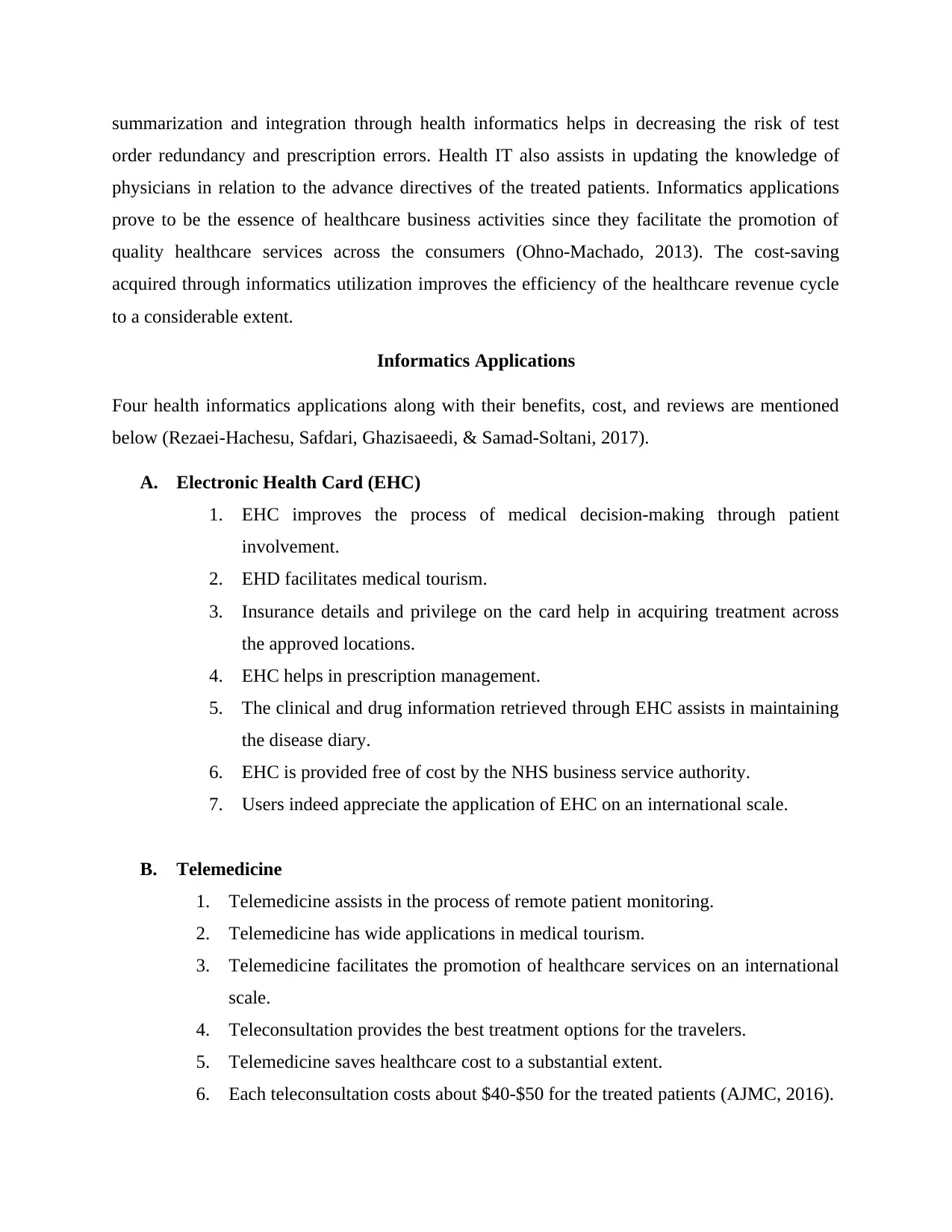
summarization and integration through health informatics helps in decreasing the risk of test
order redundancy and prescription errors. Health IT also assists in updating the knowledge of
physicians in relation to the advance directives of the treated patients. Informatics applications
prove to be the essence of healthcare business activities since they facilitate the promotion of
quality healthcare services across the consumers (Ohno-Machado, 2013). The cost-saving
acquired through informatics utilization improves the efficiency of the healthcare revenue cycle
to a considerable extent.
Informatics Applications
Four health informatics applications along with their benefits, cost, and reviews are mentioned
below (Rezaei-Hachesu, Safdari, Ghazisaeedi, & Samad-Soltani, 2017).
A. Electronic Health Card (EHC)
1. EHC improves the process of medical decision-making through patient
involvement.
2. EHD facilitates medical tourism.
3. Insurance details and privilege on the card help in acquiring treatment across
the approved locations.
4. EHC helps in prescription management.
5. The clinical and drug information retrieved through EHC assists in maintaining
the disease diary.
6. EHC is provided free of cost by the NHS business service authority.
7. Users indeed appreciate the application of EHC on an international scale.
B. Telemedicine
1. Telemedicine assists in the process of remote patient monitoring.
2. Telemedicine has wide applications in medical tourism.
3. Telemedicine facilitates the promotion of healthcare services on an international
scale.
4. Teleconsultation provides the best treatment options for the travelers.
5. Telemedicine saves healthcare cost to a substantial extent.
6. Each teleconsultation costs about $40-$50 for the treated patients (AJMC, 2016).
order redundancy and prescription errors. Health IT also assists in updating the knowledge of
physicians in relation to the advance directives of the treated patients. Informatics applications
prove to be the essence of healthcare business activities since they facilitate the promotion of
quality healthcare services across the consumers (Ohno-Machado, 2013). The cost-saving
acquired through informatics utilization improves the efficiency of the healthcare revenue cycle
to a considerable extent.
Informatics Applications
Four health informatics applications along with their benefits, cost, and reviews are mentioned
below (Rezaei-Hachesu, Safdari, Ghazisaeedi, & Samad-Soltani, 2017).
A. Electronic Health Card (EHC)
1. EHC improves the process of medical decision-making through patient
involvement.
2. EHD facilitates medical tourism.
3. Insurance details and privilege on the card help in acquiring treatment across
the approved locations.
4. EHC helps in prescription management.
5. The clinical and drug information retrieved through EHC assists in maintaining
the disease diary.
6. EHC is provided free of cost by the NHS business service authority.
7. Users indeed appreciate the application of EHC on an international scale.
B. Telemedicine
1. Telemedicine assists in the process of remote patient monitoring.
2. Telemedicine has wide applications in medical tourism.
3. Telemedicine facilitates the promotion of healthcare services on an international
scale.
4. Teleconsultation provides the best treatment options for the travelers.
5. Telemedicine saves healthcare cost to a substantial extent.
6. Each teleconsultation costs about $40-$50 for the treated patients (AJMC, 2016).
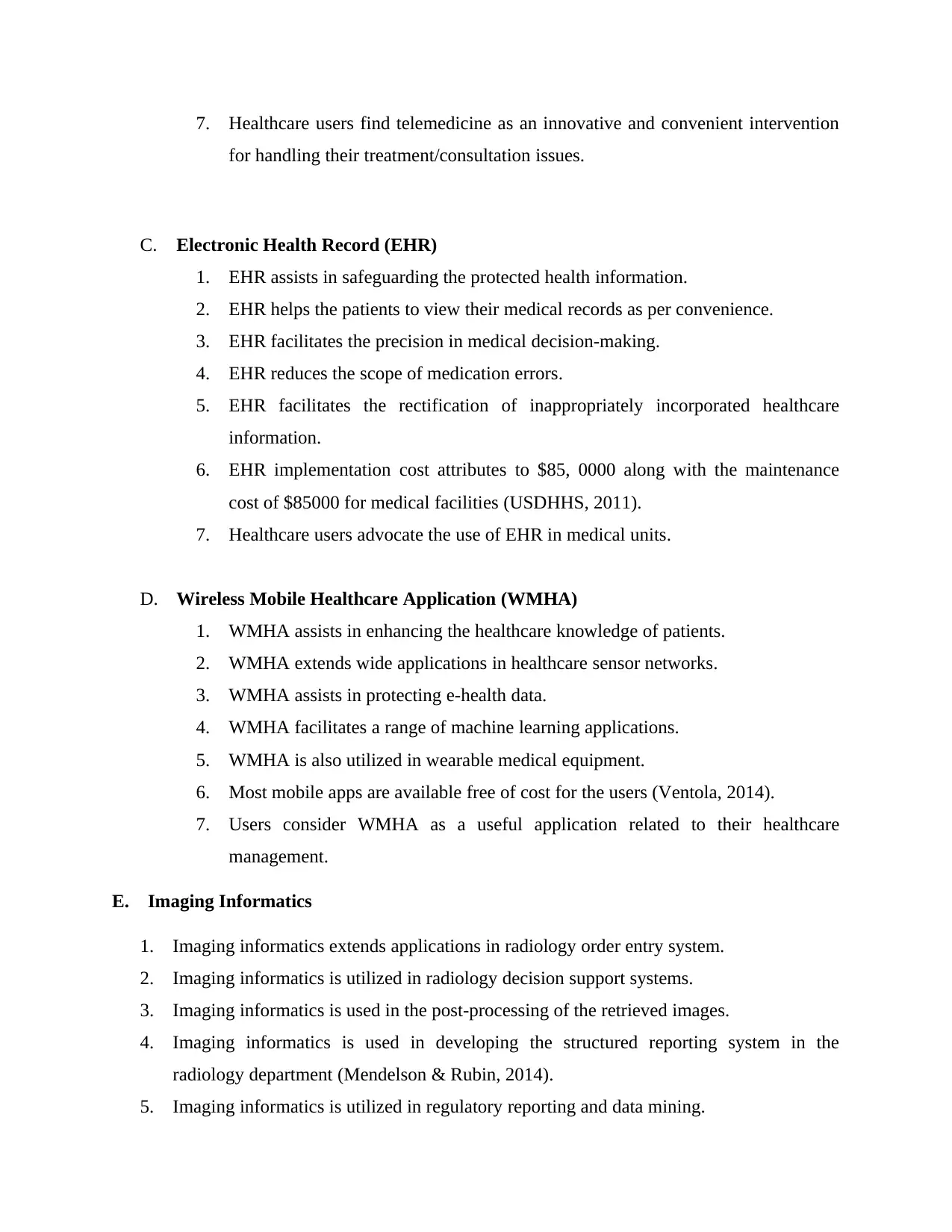
7. Healthcare users find telemedicine as an innovative and convenient intervention
for handling their treatment/consultation issues.
C. Electronic Health Record (EHR)
1. EHR assists in safeguarding the protected health information.
2. EHR helps the patients to view their medical records as per convenience.
3. EHR facilitates the precision in medical decision-making.
4. EHR reduces the scope of medication errors.
5. EHR facilitates the rectification of inappropriately incorporated healthcare
information.
6. EHR implementation cost attributes to $85, 0000 along with the maintenance
cost of $85000 for medical facilities (USDHHS, 2011).
7. Healthcare users advocate the use of EHR in medical units.
D. Wireless Mobile Healthcare Application (WMHA)
1. WMHA assists in enhancing the healthcare knowledge of patients.
2. WMHA extends wide applications in healthcare sensor networks.
3. WMHA assists in protecting e-health data.
4. WMHA facilitates a range of machine learning applications.
5. WMHA is also utilized in wearable medical equipment.
6. Most mobile apps are available free of cost for the users (Ventola, 2014).
7. Users consider WMHA as a useful application related to their healthcare
management.
E. Imaging Informatics
1. Imaging informatics extends applications in radiology order entry system.
2. Imaging informatics is utilized in radiology decision support systems.
3. Imaging informatics is used in the post-processing of the retrieved images.
4. Imaging informatics is used in developing the structured reporting system in the
radiology department (Mendelson & Rubin, 2014).
5. Imaging informatics is utilized in regulatory reporting and data mining.
for handling their treatment/consultation issues.
C. Electronic Health Record (EHR)
1. EHR assists in safeguarding the protected health information.
2. EHR helps the patients to view their medical records as per convenience.
3. EHR facilitates the precision in medical decision-making.
4. EHR reduces the scope of medication errors.
5. EHR facilitates the rectification of inappropriately incorporated healthcare
information.
6. EHR implementation cost attributes to $85, 0000 along with the maintenance
cost of $85000 for medical facilities (USDHHS, 2011).
7. Healthcare users advocate the use of EHR in medical units.
D. Wireless Mobile Healthcare Application (WMHA)
1. WMHA assists in enhancing the healthcare knowledge of patients.
2. WMHA extends wide applications in healthcare sensor networks.
3. WMHA assists in protecting e-health data.
4. WMHA facilitates a range of machine learning applications.
5. WMHA is also utilized in wearable medical equipment.
6. Most mobile apps are available free of cost for the users (Ventola, 2014).
7. Users consider WMHA as a useful application related to their healthcare
management.
E. Imaging Informatics
1. Imaging informatics extends applications in radiology order entry system.
2. Imaging informatics is utilized in radiology decision support systems.
3. Imaging informatics is used in the post-processing of the retrieved images.
4. Imaging informatics is used in developing the structured reporting system in the
radiology department (Mendelson & Rubin, 2014).
5. Imaging informatics is utilized in regulatory reporting and data mining.
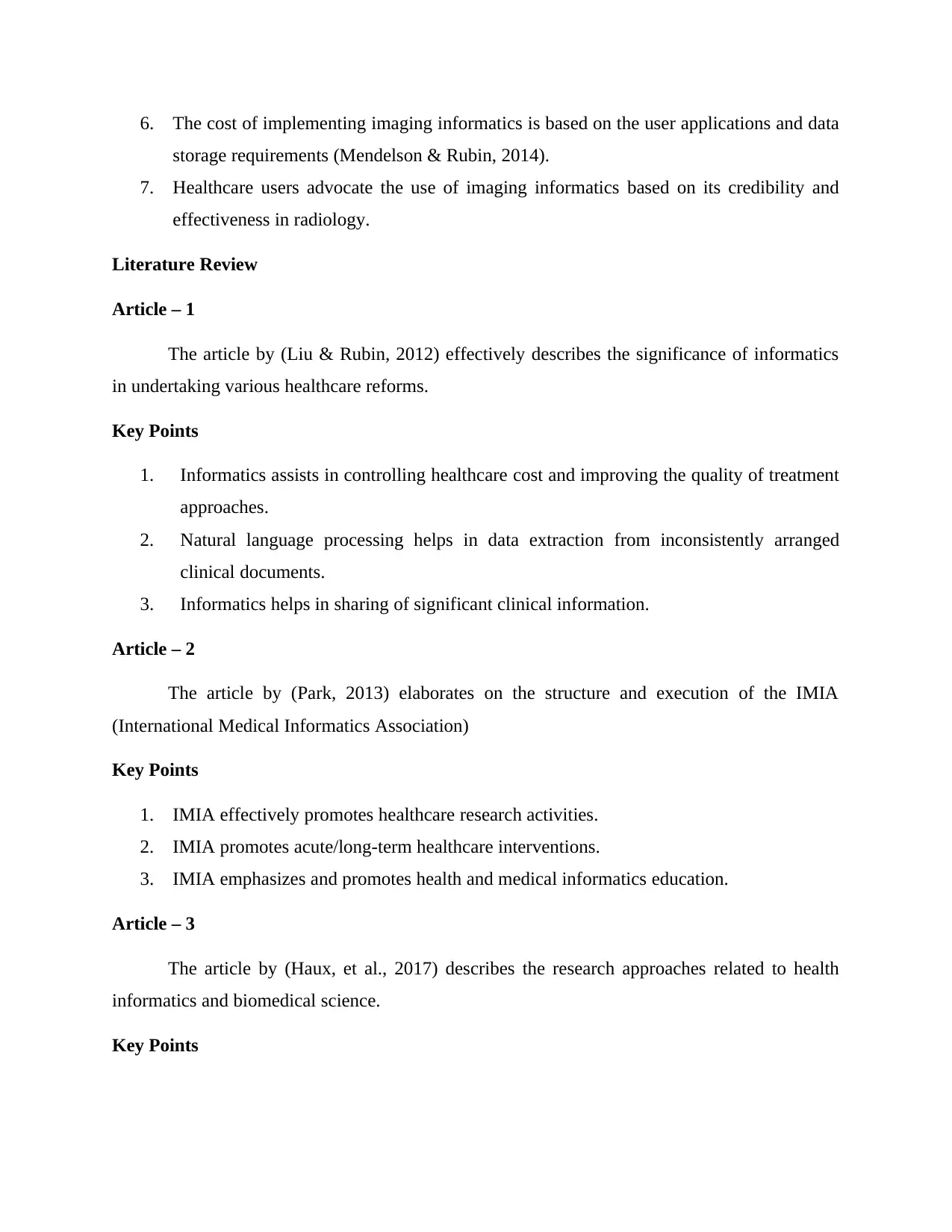
6. The cost of implementing imaging informatics is based on the user applications and data
storage requirements (Mendelson & Rubin, 2014).
7. Healthcare users advocate the use of imaging informatics based on its credibility and
effectiveness in radiology.
Literature Review
Article – 1
The article by (Liu & Rubin, 2012) effectively describes the significance of informatics
in undertaking various healthcare reforms.
Key Points
1. Informatics assists in controlling healthcare cost and improving the quality of treatment
approaches.
2. Natural language processing helps in data extraction from inconsistently arranged
clinical documents.
3. Informatics helps in sharing of significant clinical information.
Article – 2
The article by (Park, 2013) elaborates on the structure and execution of the IMIA
(International Medical Informatics Association)
Key Points
1. IMIA effectively promotes healthcare research activities.
2. IMIA promotes acute/long-term healthcare interventions.
3. IMIA emphasizes and promotes health and medical informatics education.
Article – 3
The article by (Haux, et al., 2017) describes the research approaches related to health
informatics and biomedical science.
Key Points
storage requirements (Mendelson & Rubin, 2014).
7. Healthcare users advocate the use of imaging informatics based on its credibility and
effectiveness in radiology.
Literature Review
Article – 1
The article by (Liu & Rubin, 2012) effectively describes the significance of informatics
in undertaking various healthcare reforms.
Key Points
1. Informatics assists in controlling healthcare cost and improving the quality of treatment
approaches.
2. Natural language processing helps in data extraction from inconsistently arranged
clinical documents.
3. Informatics helps in sharing of significant clinical information.
Article – 2
The article by (Park, 2013) elaborates on the structure and execution of the IMIA
(International Medical Informatics Association)
Key Points
1. IMIA effectively promotes healthcare research activities.
2. IMIA promotes acute/long-term healthcare interventions.
3. IMIA emphasizes and promotes health and medical informatics education.
Article – 3
The article by (Haux, et al., 2017) describes the research approaches related to health
informatics and biomedical science.
Key Points
Secure Best Marks with AI Grader
Need help grading? Try our AI Grader for instant feedback on your assignments.
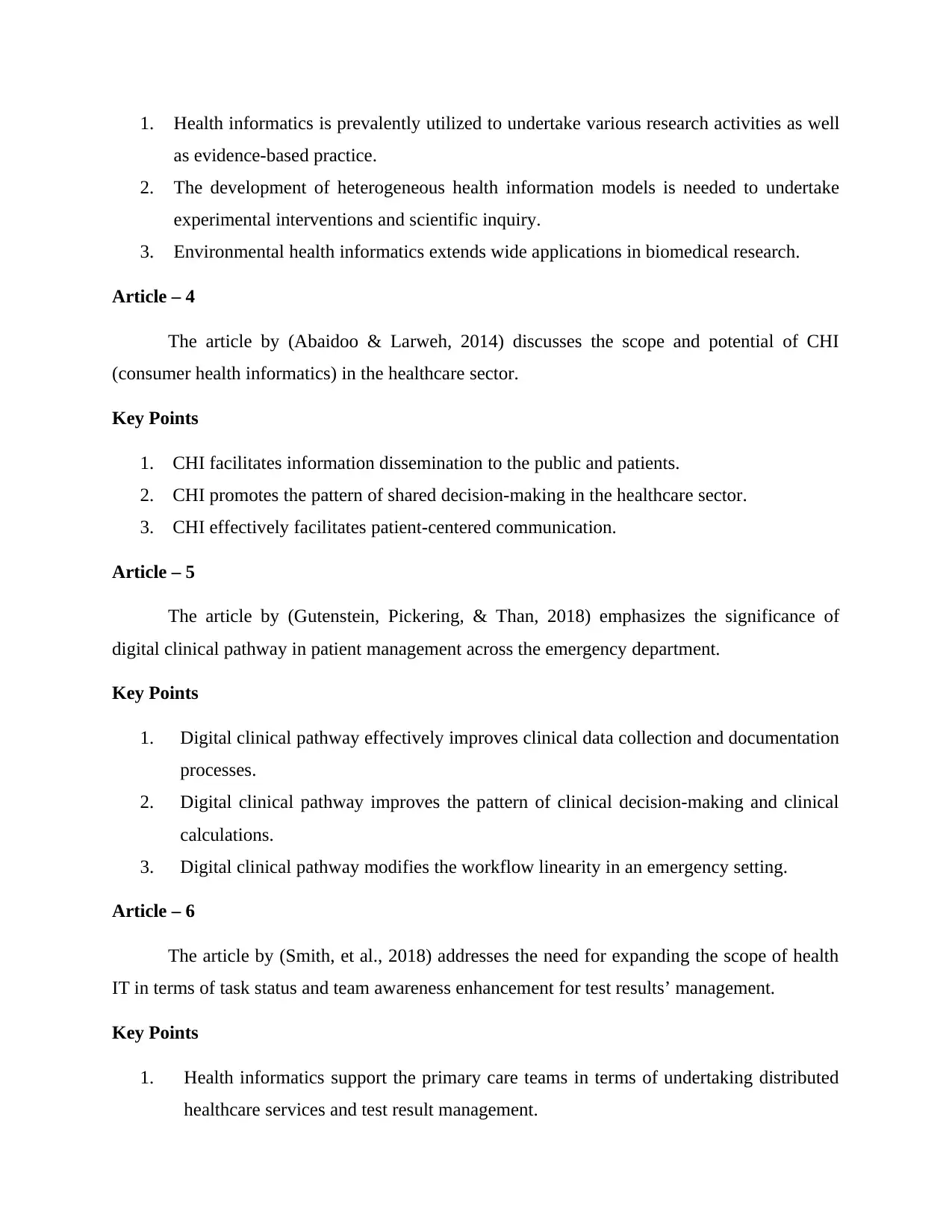
1. Health informatics is prevalently utilized to undertake various research activities as well
as evidence-based practice.
2. The development of heterogeneous health information models is needed to undertake
experimental interventions and scientific inquiry.
3. Environmental health informatics extends wide applications in biomedical research.
Article – 4
The article by (Abaidoo & Larweh, 2014) discusses the scope and potential of CHI
(consumer health informatics) in the healthcare sector.
Key Points
1. CHI facilitates information dissemination to the public and patients.
2. CHI promotes the pattern of shared decision-making in the healthcare sector.
3. CHI effectively facilitates patient-centered communication.
Article – 5
The article by (Gutenstein, Pickering, & Than, 2018) emphasizes the significance of
digital clinical pathway in patient management across the emergency department.
Key Points
1. Digital clinical pathway effectively improves clinical data collection and documentation
processes.
2. Digital clinical pathway improves the pattern of clinical decision-making and clinical
calculations.
3. Digital clinical pathway modifies the workflow linearity in an emergency setting.
Article – 6
The article by (Smith, et al., 2018) addresses the need for expanding the scope of health
IT in terms of task status and team awareness enhancement for test results’ management.
Key Points
1. Health informatics support the primary care teams in terms of undertaking distributed
healthcare services and test result management.
as evidence-based practice.
2. The development of heterogeneous health information models is needed to undertake
experimental interventions and scientific inquiry.
3. Environmental health informatics extends wide applications in biomedical research.
Article – 4
The article by (Abaidoo & Larweh, 2014) discusses the scope and potential of CHI
(consumer health informatics) in the healthcare sector.
Key Points
1. CHI facilitates information dissemination to the public and patients.
2. CHI promotes the pattern of shared decision-making in the healthcare sector.
3. CHI effectively facilitates patient-centered communication.
Article – 5
The article by (Gutenstein, Pickering, & Than, 2018) emphasizes the significance of
digital clinical pathway in patient management across the emergency department.
Key Points
1. Digital clinical pathway effectively improves clinical data collection and documentation
processes.
2. Digital clinical pathway improves the pattern of clinical decision-making and clinical
calculations.
3. Digital clinical pathway modifies the workflow linearity in an emergency setting.
Article – 6
The article by (Smith, et al., 2018) addresses the need for expanding the scope of health
IT in terms of task status and team awareness enhancement for test results’ management.
Key Points
1. Health informatics support the primary care teams in terms of undertaking distributed
healthcare services and test result management.
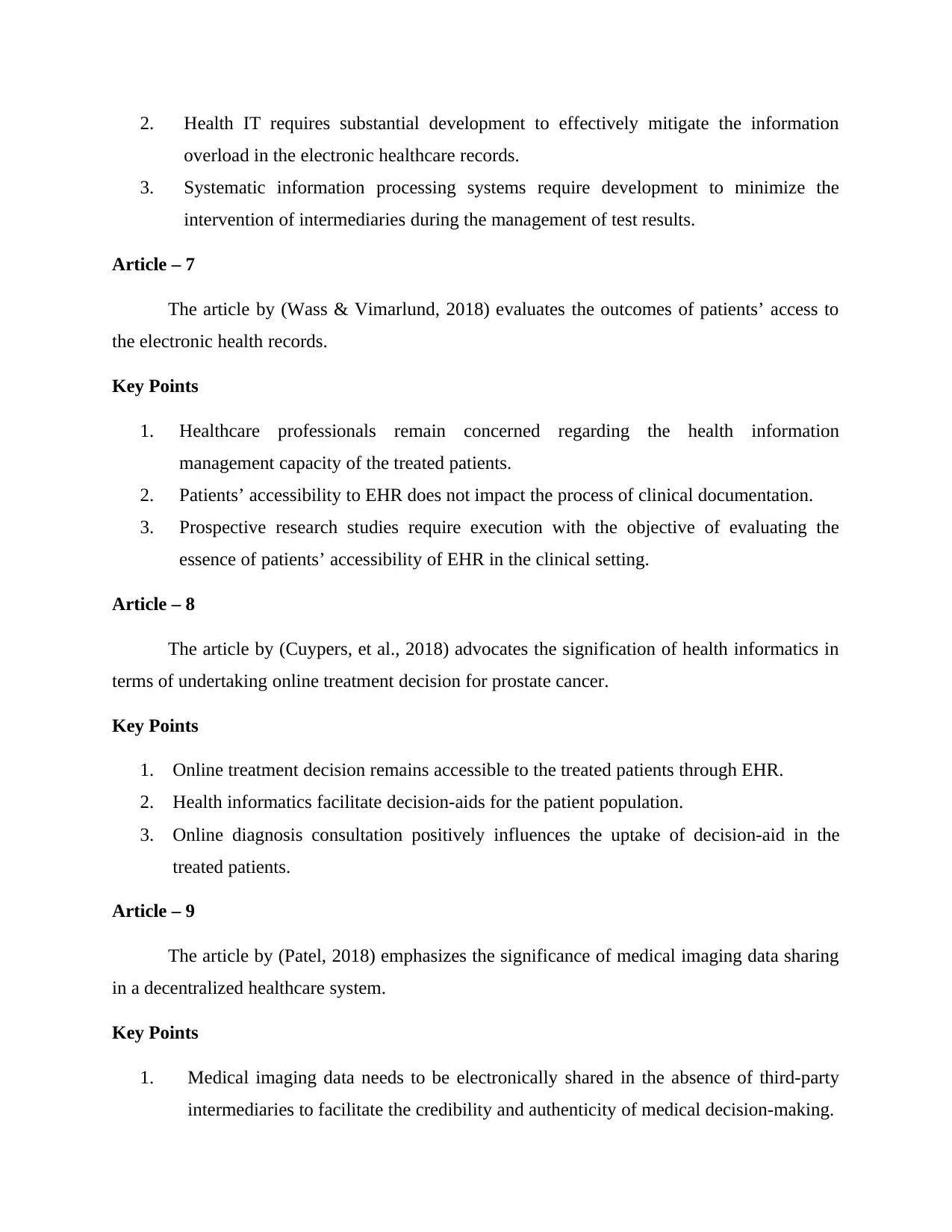
2. Health IT requires substantial development to effectively mitigate the information
overload in the electronic healthcare records.
3. Systematic information processing systems require development to minimize the
intervention of intermediaries during the management of test results.
Article – 7
The article by (Wass & Vimarlund, 2018) evaluates the outcomes of patients’ access to
the electronic health records.
Key Points
1. Healthcare professionals remain concerned regarding the health information
management capacity of the treated patients.
2. Patients’ accessibility to EHR does not impact the process of clinical documentation.
3. Prospective research studies require execution with the objective of evaluating the
essence of patients’ accessibility of EHR in the clinical setting.
Article – 8
The article by (Cuypers, et al., 2018) advocates the signification of health informatics in
terms of undertaking online treatment decision for prostate cancer.
Key Points
1. Online treatment decision remains accessible to the treated patients through EHR.
2. Health informatics facilitate decision-aids for the patient population.
3. Online diagnosis consultation positively influences the uptake of decision-aid in the
treated patients.
Article – 9
The article by (Patel, 2018) emphasizes the significance of medical imaging data sharing
in a decentralized healthcare system.
Key Points
1. Medical imaging data needs to be electronically shared in the absence of third-party
intermediaries to facilitate the credibility and authenticity of medical decision-making.
overload in the electronic healthcare records.
3. Systematic information processing systems require development to minimize the
intervention of intermediaries during the management of test results.
Article – 7
The article by (Wass & Vimarlund, 2018) evaluates the outcomes of patients’ access to
the electronic health records.
Key Points
1. Healthcare professionals remain concerned regarding the health information
management capacity of the treated patients.
2. Patients’ accessibility to EHR does not impact the process of clinical documentation.
3. Prospective research studies require execution with the objective of evaluating the
essence of patients’ accessibility of EHR in the clinical setting.
Article – 8
The article by (Cuypers, et al., 2018) advocates the signification of health informatics in
terms of undertaking online treatment decision for prostate cancer.
Key Points
1. Online treatment decision remains accessible to the treated patients through EHR.
2. Health informatics facilitate decision-aids for the patient population.
3. Online diagnosis consultation positively influences the uptake of decision-aid in the
treated patients.
Article – 9
The article by (Patel, 2018) emphasizes the significance of medical imaging data sharing
in a decentralized healthcare system.
Key Points
1. Medical imaging data needs to be electronically shared in the absence of third-party
intermediaries to facilitate the credibility and authenticity of medical decision-making.
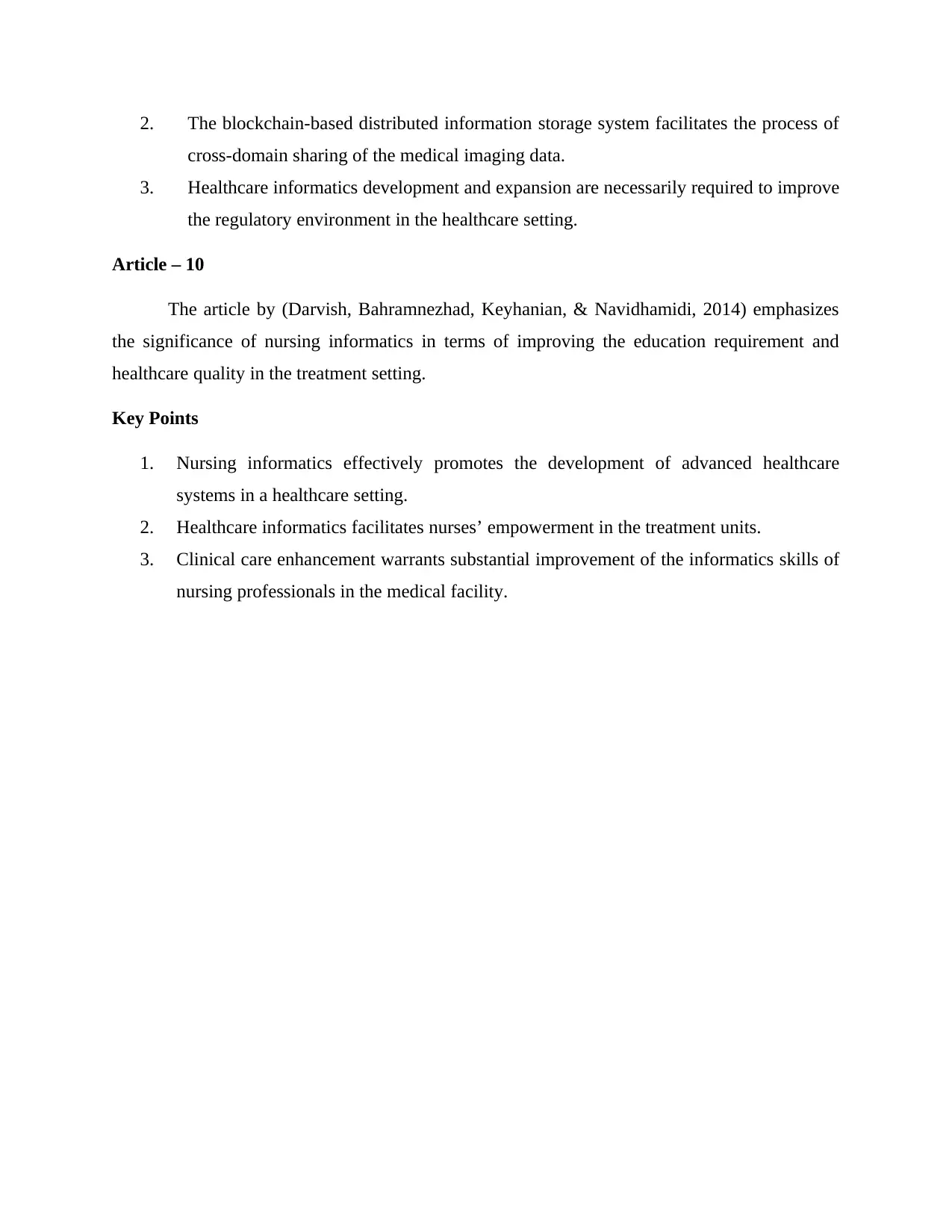
2. The blockchain-based distributed information storage system facilitates the process of
cross-domain sharing of the medical imaging data.
3. Healthcare informatics development and expansion are necessarily required to improve
the regulatory environment in the healthcare setting.
Article – 10
The article by (Darvish, Bahramnezhad, Keyhanian, & Navidhamidi, 2014) emphasizes
the significance of nursing informatics in terms of improving the education requirement and
healthcare quality in the treatment setting.
Key Points
1. Nursing informatics effectively promotes the development of advanced healthcare
systems in a healthcare setting.
2. Healthcare informatics facilitates nurses’ empowerment in the treatment units.
3. Clinical care enhancement warrants substantial improvement of the informatics skills of
nursing professionals in the medical facility.
cross-domain sharing of the medical imaging data.
3. Healthcare informatics development and expansion are necessarily required to improve
the regulatory environment in the healthcare setting.
Article – 10
The article by (Darvish, Bahramnezhad, Keyhanian, & Navidhamidi, 2014) emphasizes
the significance of nursing informatics in terms of improving the education requirement and
healthcare quality in the treatment setting.
Key Points
1. Nursing informatics effectively promotes the development of advanced healthcare
systems in a healthcare setting.
2. Healthcare informatics facilitates nurses’ empowerment in the treatment units.
3. Clinical care enhancement warrants substantial improvement of the informatics skills of
nursing professionals in the medical facility.
Paraphrase This Document
Need a fresh take? Get an instant paraphrase of this document with our AI Paraphraser
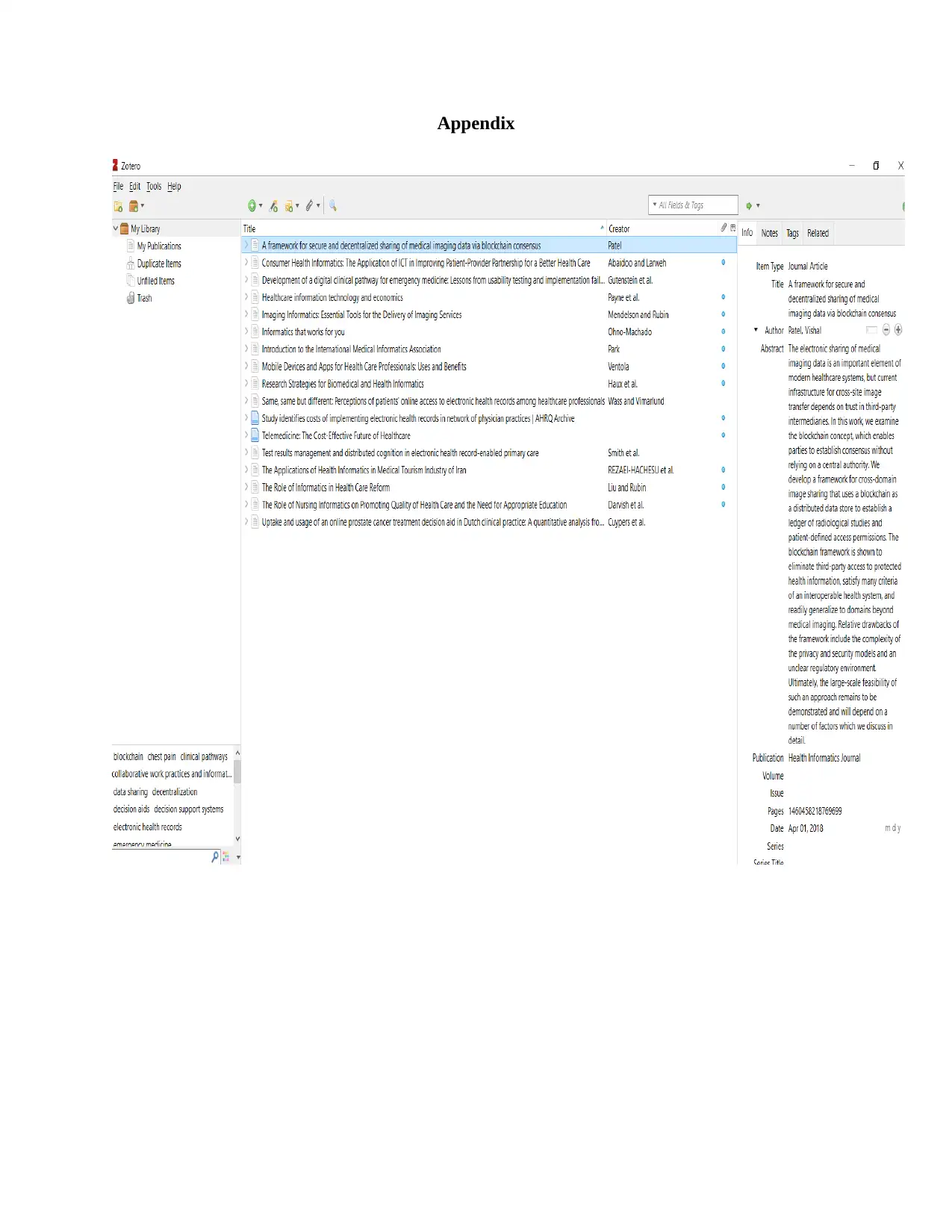
Appendix
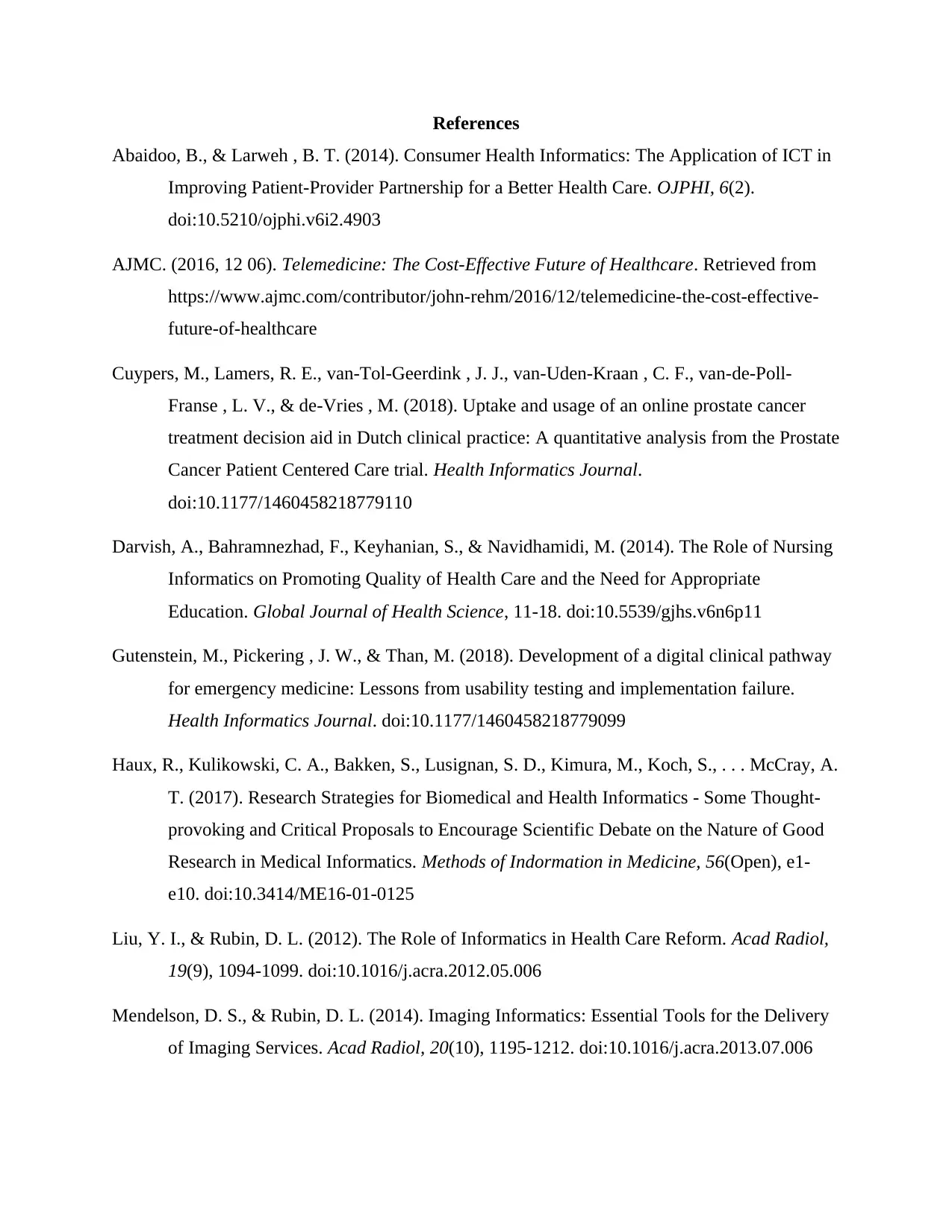
References
Abaidoo, B., & Larweh , B. T. (2014). Consumer Health Informatics: The Application of ICT in
Improving Patient-Provider Partnership for a Better Health Care. OJPHI, 6(2).
doi:10.5210/ojphi.v6i2.4903
AJMC. (2016, 12 06). Telemedicine: The Cost-Effective Future of Healthcare. Retrieved from
https://www.ajmc.com/contributor/john-rehm/2016/12/telemedicine-the-cost-effective-
future-of-healthcare
Cuypers, M., Lamers, R. E., van-Tol-Geerdink , J. J., van-Uden-Kraan , C. F., van-de-Poll-
Franse , L. V., & de-Vries , M. (2018). Uptake and usage of an online prostate cancer
treatment decision aid in Dutch clinical practice: A quantitative analysis from the Prostate
Cancer Patient Centered Care trial. Health Informatics Journal.
doi:10.1177/1460458218779110
Darvish, A., Bahramnezhad, F., Keyhanian, S., & Navidhamidi, M. (2014). The Role of Nursing
Informatics on Promoting Quality of Health Care and the Need for Appropriate
Education. Global Journal of Health Science, 11-18. doi:10.5539/gjhs.v6n6p11
Gutenstein, M., Pickering , J. W., & Than, M. (2018). Development of a digital clinical pathway
for emergency medicine: Lessons from usability testing and implementation failure.
Health Informatics Journal. doi:10.1177/1460458218779099
Haux, R., Kulikowski, C. A., Bakken, S., Lusignan, S. D., Kimura, M., Koch, S., . . . McCray, A.
T. (2017). Research Strategies for Biomedical and Health Informatics - Some Thought-
provoking and Critical Proposals to Encourage Scientific Debate on the Nature of Good
Research in Medical Informatics. Methods of Indormation in Medicine, 56(Open), e1-
e10. doi:10.3414/ME16-01-0125
Liu, Y. I., & Rubin, D. L. (2012). The Role of Informatics in Health Care Reform. Acad Radiol,
19(9), 1094-1099. doi:10.1016/j.acra.2012.05.006
Mendelson, D. S., & Rubin, D. L. (2014). Imaging Informatics: Essential Tools for the Delivery
of Imaging Services. Acad Radiol, 20(10), 1195-1212. doi:10.1016/j.acra.2013.07.006
Abaidoo, B., & Larweh , B. T. (2014). Consumer Health Informatics: The Application of ICT in
Improving Patient-Provider Partnership for a Better Health Care. OJPHI, 6(2).
doi:10.5210/ojphi.v6i2.4903
AJMC. (2016, 12 06). Telemedicine: The Cost-Effective Future of Healthcare. Retrieved from
https://www.ajmc.com/contributor/john-rehm/2016/12/telemedicine-the-cost-effective-
future-of-healthcare
Cuypers, M., Lamers, R. E., van-Tol-Geerdink , J. J., van-Uden-Kraan , C. F., van-de-Poll-
Franse , L. V., & de-Vries , M. (2018). Uptake and usage of an online prostate cancer
treatment decision aid in Dutch clinical practice: A quantitative analysis from the Prostate
Cancer Patient Centered Care trial. Health Informatics Journal.
doi:10.1177/1460458218779110
Darvish, A., Bahramnezhad, F., Keyhanian, S., & Navidhamidi, M. (2014). The Role of Nursing
Informatics on Promoting Quality of Health Care and the Need for Appropriate
Education. Global Journal of Health Science, 11-18. doi:10.5539/gjhs.v6n6p11
Gutenstein, M., Pickering , J. W., & Than, M. (2018). Development of a digital clinical pathway
for emergency medicine: Lessons from usability testing and implementation failure.
Health Informatics Journal. doi:10.1177/1460458218779099
Haux, R., Kulikowski, C. A., Bakken, S., Lusignan, S. D., Kimura, M., Koch, S., . . . McCray, A.
T. (2017). Research Strategies for Biomedical and Health Informatics - Some Thought-
provoking and Critical Proposals to Encourage Scientific Debate on the Nature of Good
Research in Medical Informatics. Methods of Indormation in Medicine, 56(Open), e1-
e10. doi:10.3414/ME16-01-0125
Liu, Y. I., & Rubin, D. L. (2012). The Role of Informatics in Health Care Reform. Acad Radiol,
19(9), 1094-1099. doi:10.1016/j.acra.2012.05.006
Mendelson, D. S., & Rubin, D. L. (2014). Imaging Informatics: Essential Tools for the Delivery
of Imaging Services. Acad Radiol, 20(10), 1195-1212. doi:10.1016/j.acra.2013.07.006
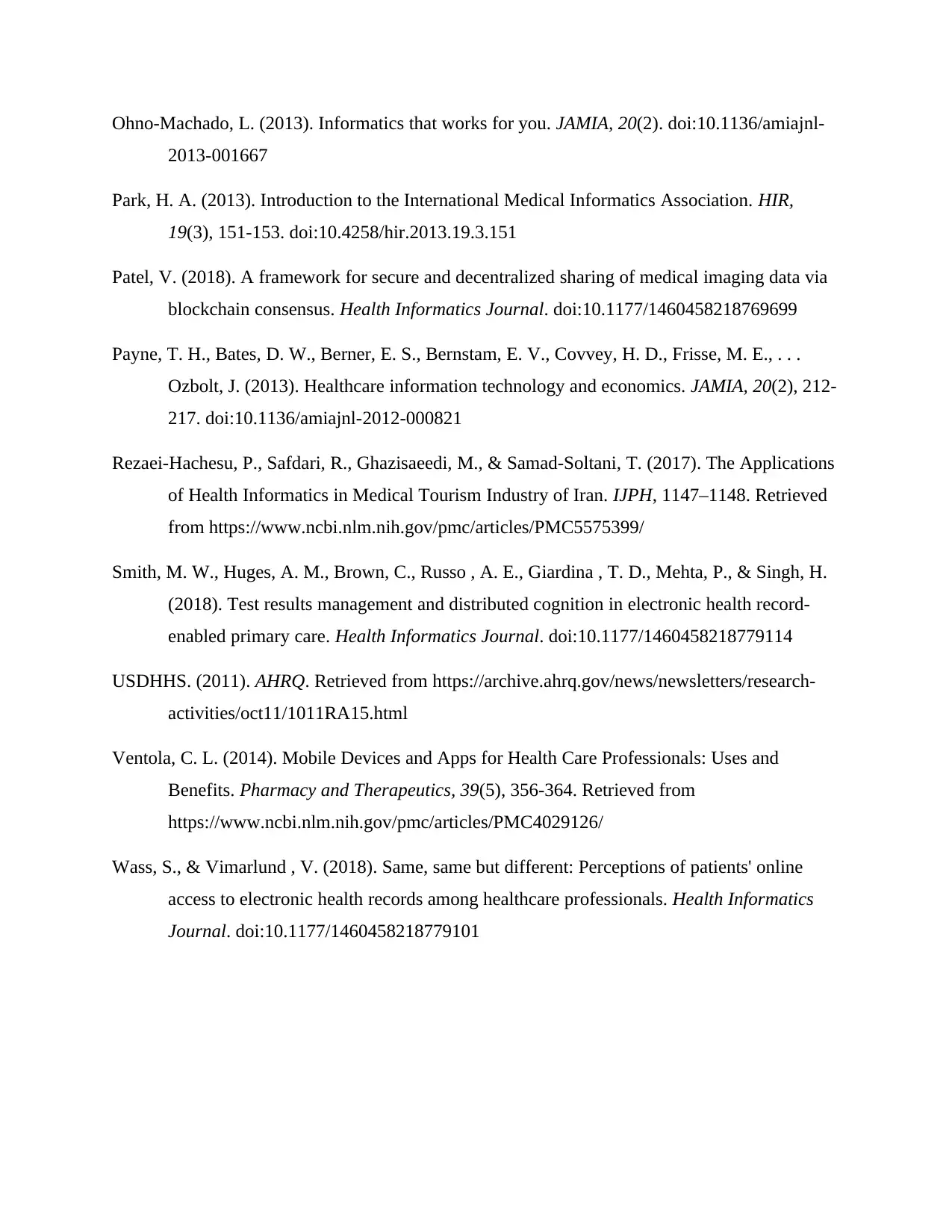
Ohno-Machado, L. (2013). Informatics that works for you. JAMIA, 20(2). doi:10.1136/amiajnl-
2013-001667
Park, H. A. (2013). Introduction to the International Medical Informatics Association. HIR,
19(3), 151-153. doi:10.4258/hir.2013.19.3.151
Patel, V. (2018). A framework for secure and decentralized sharing of medical imaging data via
blockchain consensus. Health Informatics Journal. doi:10.1177/1460458218769699
Payne, T. H., Bates, D. W., Berner, E. S., Bernstam, E. V., Covvey, H. D., Frisse, M. E., . . .
Ozbolt, J. (2013). Healthcare information technology and economics. JAMIA, 20(2), 212-
217. doi:10.1136/amiajnl-2012-000821
Rezaei-Hachesu, P., Safdari, R., Ghazisaeedi, M., & Samad-Soltani, T. (2017). The Applications
of Health Informatics in Medical Tourism Industry of Iran. IJPH, 1147–1148. Retrieved
from https://www.ncbi.nlm.nih.gov/pmc/articles/PMC5575399/
Smith, M. W., Huges, A. M., Brown, C., Russo , A. E., Giardina , T. D., Mehta, P., & Singh, H.
(2018). Test results management and distributed cognition in electronic health record-
enabled primary care. Health Informatics Journal. doi:10.1177/1460458218779114
USDHHS. (2011). AHRQ. Retrieved from https://archive.ahrq.gov/news/newsletters/research-
activities/oct11/1011RA15.html
Ventola, C. L. (2014). Mobile Devices and Apps for Health Care Professionals: Uses and
Benefits. Pharmacy and Therapeutics, 39(5), 356-364. Retrieved from
https://www.ncbi.nlm.nih.gov/pmc/articles/PMC4029126/
Wass, S., & Vimarlund , V. (2018). Same, same but different: Perceptions of patients' online
access to electronic health records among healthcare professionals. Health Informatics
Journal. doi:10.1177/1460458218779101
2013-001667
Park, H. A. (2013). Introduction to the International Medical Informatics Association. HIR,
19(3), 151-153. doi:10.4258/hir.2013.19.3.151
Patel, V. (2018). A framework for secure and decentralized sharing of medical imaging data via
blockchain consensus. Health Informatics Journal. doi:10.1177/1460458218769699
Payne, T. H., Bates, D. W., Berner, E. S., Bernstam, E. V., Covvey, H. D., Frisse, M. E., . . .
Ozbolt, J. (2013). Healthcare information technology and economics. JAMIA, 20(2), 212-
217. doi:10.1136/amiajnl-2012-000821
Rezaei-Hachesu, P., Safdari, R., Ghazisaeedi, M., & Samad-Soltani, T. (2017). The Applications
of Health Informatics in Medical Tourism Industry of Iran. IJPH, 1147–1148. Retrieved
from https://www.ncbi.nlm.nih.gov/pmc/articles/PMC5575399/
Smith, M. W., Huges, A. M., Brown, C., Russo , A. E., Giardina , T. D., Mehta, P., & Singh, H.
(2018). Test results management and distributed cognition in electronic health record-
enabled primary care. Health Informatics Journal. doi:10.1177/1460458218779114
USDHHS. (2011). AHRQ. Retrieved from https://archive.ahrq.gov/news/newsletters/research-
activities/oct11/1011RA15.html
Ventola, C. L. (2014). Mobile Devices and Apps for Health Care Professionals: Uses and
Benefits. Pharmacy and Therapeutics, 39(5), 356-364. Retrieved from
https://www.ncbi.nlm.nih.gov/pmc/articles/PMC4029126/
Wass, S., & Vimarlund , V. (2018). Same, same but different: Perceptions of patients' online
access to electronic health records among healthcare professionals. Health Informatics
Journal. doi:10.1177/1460458218779101
1 out of 10
Related Documents
Your All-in-One AI-Powered Toolkit for Academic Success.
+13062052269
info@desklib.com
Available 24*7 on WhatsApp / Email
![[object Object]](/_next/static/media/star-bottom.7253800d.svg)
Unlock your academic potential
© 2024 | Zucol Services PVT LTD | All rights reserved.





